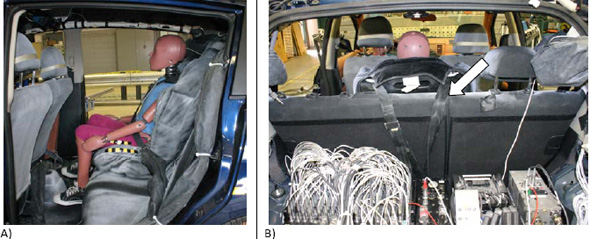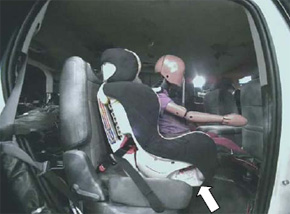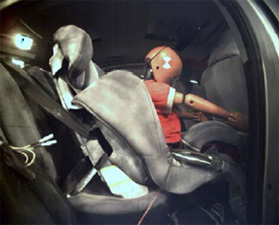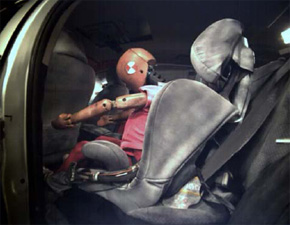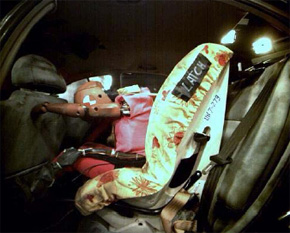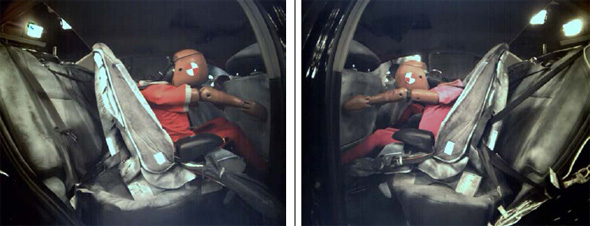INTRODUCTION
Transport Canada looked at different kinds of forward-facing child seats and different ways of attaching them to a vehicle. Our aim was to understand more about how to protect young children who weigh between 18 kg and 30 kg (40 lb and 65 lb). Transport Canada does not do in-vehicle crash tests to rate, rank, or endorse individual child seats.
Since no law in the world requires these kinds of in-vehicle crash tests to assess the safety of child seats, why does Transport Canada do them? Because vehicle seats and child seat designs change faster than standards and regulations. We look for new areas of risk and decide if current regulations need to be updated to keep children safer than ever.
WHY NOT USE A BOOSTER SEAT INSTEAD OF A CHILD CAR SEAT?
When this study began in 2003, Canadian regulations set the upper weight limit for forward-facing car seats at 22 kg or 48 lb. Once children reached this limit, they would then move from their car seat into a booster seat. Although moving from a car seat to a booster can be exciting for the growing child and the family, it may offer less protection for some children.
Why? A children's car seat uses a 5-point harness system that is built into its shell. The harness straps are narrower than a car's seat belt and fit a child's small shoulders very well. In case of a sudden stop or crash, they will hold the child back and spread the forces of the crash over the two shoulders, the chest, part of the belly and the hips. This way, the child's body can come to a controlled stop with less chance of injury.
A booster seat, on the other hand, relies on the car's lap and shoulder belt to protect a child. Instead of a harness system, it has guides that help keep the car's seat belt on the child's hips and on one shoulder. Keeping the belt on the shoulder of a small child can be difficult, especially during a crash, because a child's shoulder is much smaller and more rounded than an adult's. And even if the booster seat does a great job of keeping the belt in place during a crash, it still may not hold back a child as safely as a children's car seat would.
In a study on booster seats, we found that in many cars, the booster seats were not able to spread the forces of a crash or control the upper body or chest of the child dummy. This led us to ask whether children could be better protected if they stayed in children's car seats for as long as possible. Please refer to the separate Web page on the testing of booster seats as well as brochures available on our Web site that describe the differences between the various seat types.
WHAT KINDS OF TESTS WERE DONE?
During 2003-2009, we tested 30 different child seat models installed in the rear seats of 83 vehicles that were also undergoing frontal rigid wall crash tests designed to monitor protection for front seat occupants. Most tests were conducted at 48 km/h and the second largest group of seats was tested at 56 km/h, both of which are severe collisions. A small number were tested at 40 km/h and in the rear seats of cars crashing into the side of another vehicle at 50 km/h. Only two seats were tested in cars that were hitting a deformable barrier at 40 km/h (referred to as offset tests in the table below). The number of tests for each category is shown in Table 1.
| Rigid Wall 40 km/h | Rigid Wall 48 km/h | Rigid Wall 56 km/h | Car-to car 50 km/h | Offset 40 km/h | TOTAL | |
|---|---|---|---|---|---|---|
| Car seats | 7 | 85 | 30 | 10 | 2 | 134 |
| Cars | 4 | 52 | 18 | 7 | 2 | 83 |
We bought most of the child seats we tested from local stores. All of these were certified to meet Canadian standards. We obtained some, like the Britax Marathon, Britax Regent, and Apex65, directly from U.S. manufacturers as samples for the test program. Child seats that were sold in Canadian stores when the study began had a recommended top weight limit of 18 kg (40 lb) to 22 kg (48 lb).
We started out using two sizes of crash test dummies:
- one that was close in size and weight to a 3-year-old child and weighed 16 kg (35 lb)
- a larger dummy that was close in size to a small 6-year-old child with a weight of approximately 23 kg (51 lb). While this is slightly over the recommended limit, it is possible that many parents or guardians do not know exactly how much their child weighs. That's why we expect that some children might still be using their car seats past the 22 kg (48 lb) weight limit.
Beginning in 2005, we were able to obtain some U.S. car seats with greater weight limits. For example, the Regent, manufactured by Britax, had an upper weight limit of 80 lb (36 kg). In May 2007, the Canadian regulation was modified (for an interim period) to allow seats with a weight limit of up to 30 kg (66 lb) to be sold in Canada. We continued to use the 6 year-old dummy in our testing, but because these new seats had a higher weight limit, we also used the 10 year-old child dummy for some tests. The 10-year-old dummy weighed 35 kg (77 lb). One test was carried out with a dummy that represented a small adolescent and weighed 49 kg (108 lb). The heavier dummies, including the 6-year-old that was heavier than some recommended seat limits, were used to create a worst-case testing condition for seat attachments and vehicle anchorages.
We looked at three different ways of attaching the child seats:
- Using the seat belt of the car and the upper tether;
- Using the lower anchors (Universal Anchorage System or UAS) and the upper tether; and
- Using both the seat belt and the UAS as well as the upper tether.
Although tether usage is legally mandated both federally and in all provinces and territories, for the purposes of the research program, we also carried out five tests without the upper tether:
- In three cases we wanted to see if the lower anchors were strong enough to support the full load of the child seat and the child dummy.
- In one we wanted to see how a seat sold in the U.S. for use without a tether performed in a crash.
- In one test we used the 3-year-old dummy without the tether to see how the smaller dummy and an incorrectly installed seat would do in a crash.
The methods of attachment were compared in pairs of side-by-side tests in the same vehicle crash. One method was used for the child seat installed behind the driver and a second method was used for the second child seat installed behind the passenger seat. The only thing that differed was how the seat was attached to the vehicle. The child seat model, the size of dummy and the crash conditions were all the same.
Because we were comparing different ways of attaching the child seat to the vehicle and not the performance of the seat models, we re-used some seats after we inspected them carefully. In addition, if any seat showed signs of failure during a test, after it had already been used once before, the results for that test were not included in our study.
RESULTS
We tested 134 forward-facing child seats installed in 83 different motor vehicles. Overall, all seats provided excellent protection–even in the more severe crash tests.
The results are presented for each of the 3, 6 and 10 year-old dummies and then for comparison of attachment methods:
- seat belt versus UAS, and
- seat belt with UAS attachment, and
- UAS only.
THE 3-YEAR-OLD
We conducted the tests with the 3-year-old dummy at the very beginning of the program in 2003 and 2004, so many of the seats shown may no longer be available. In all, we conducted 11 tests using either the seat belt or the UAS. All but one seat were installed with the upper tether. All seats in this sample were new.
All of the 10 child seats installed with the upper tether performed very well. In the one test where the upper tether was not used, the Evenflo Titan 1 child seat was damaged. This was an older model seat. It had two straps that came over the shoulders and one strap that clipped into place between the child's legs. During the 48 km/h rigid wall test the dummy turned towards the front of the vehicle, as expected. As the child seat harnesses held the dummy back, the plastic shell through which the harnesses were threaded, ripped. Even though this caused the dummy to move further forward, the seat did a good job of absorbing the energy of the crash. Because the plastic tore, it absorbed some of the forces of the crash, keeping them low enough that the child would not be injured.
THE 6-YEAR-OLD
We used the 6-year-old dummy in 110 tests. Most seats performed very well and provided good protection. We did note a few results that were out of the ordinary. No matter how the child seat was attached to the vehicle, during severe crash tests, the dummies moved suddenly towards the front of the vehicle. This stretched the harnesses as the child seat tried to hold the child dummy back. This forward movement makes the amount of space between the back seat where the child seat was installed and the seat in front, very important. The more space in front of the dummy, the less likely it was that it would hit its head on the seat in front. Figure 1A shows how much space there is when the front seat is placed in its most forward position, while Figure 1B shows how little space there is when the front seat is in the rearmost position.
FIGURE 1: (A) SPACE AVAILABLE WHEN THE FRONT SEAT WAS IN THE FRONT MOST POSITION; (B) SPACE AVAILABLE WHEN THE FRONT SEAT WAS IN THE FRONT MOST POSITION;
In some crashes the forces were so high that the child dummy tore the shoulder harness from the plastic mould it passed through. In eight tests the dummy pulled the harnesses through the child seat and in one, a chest clip broke. These seats were each being used for the first time and included:
- two Graco Cargo seats installed in one vehicle during a 48 km/h rigid barrier crash test;
- four Britax Marathon seats installed in three vehicles during 56 km/h tests; and
- two Evenflo Bolero seats installed in one vehicle during a 56 km/h test.
The 6 year-old dummies seated in the Graco Cargo and Evenflo Bolero seats were over the recommended weight limit for these seats by approximately 2-3 kg (4-5 lb). At the time, the Britax seats were being sold in Canada with a recommended weight limit of 22 kg (48 lb). The harnesses in these eight seats tore through the seats, but the injury measures were within acceptable limits for seven of the eight. The dummy in the Marathon seat installed behind the passenger seat of a Ford Fusion hit the front passenger seat with its head. The Marathon harness did not pull through the shell in 10 other tests carried out with the 6-year-old dummy. The crash speeds for these other tests were between 48 and 56 km/h.
When the harness stops a dummy from moving forward during a crash, the dummy's chest gets pushed in or compressed. The distance that its chest is pushed in should always be less than 40 mm. In our tests, the chest compressions were all less than 33 mm and in 99 of the 110 tests they were less than 25 mm. This is because the 5-point harnesses in all the seats tested did a great job of spreading the forces over the dummy's chest, shoulders and hips. By spreading the forces evenly over a larger area, the chest is protected and the risk of chest injury is much lower.
There were no lower anchor or tether bolt failures in any of the tests.
THE 10-YEAR-OLD
We used the 10-year-old dummy in 10 tests. We used the Britax Regent in nine of them because it was the only seat we had that could fit the 10-year-old dummy. We used the APEX 65 in one test to measure the forces at the anchorage points. Three seats, including the APEX 65, were installed without using the upper tether to really test the lower anchors at a high load. All but one of the 10 seats were installed with the lower anchors.
All of the seats performed well overall. The two dummies in the Regent and APEX 65 seats without the upper tether hit the seat in front of them with their heads. One dummy in a Regent seat attached with the upper tether and UAS, also hit its head on the seat in front. Test speeds were 56 km/h for the two Regents and 48 km/h for the APEX 65.
We observed one UAS failure in a 2007 Nissan Versa. The Regent seat was installed in the center seating position with the UAS and upper tether. The installation shown in Figure 2A was not a recommended seating position for the Versa. Figure 2B shows the Regent's 'V' shaped double tether.
During the 56 km/h crash, the right tether strap shown by the arrow in Figure 2B, slipped into the space between the seat backs and caused an abrupt shift in the forces. Figure 3A shows where the tether strap ended up and Figure 3B is a photo of the failed anchor in the vehicle. The child dummy remained in his car seat and the injury measures were not serious. The test makes it clear that you must follow two important steps when you install a child seat with the UAS and upper tether.
- Always read the car's user manual to make sure that you can use the center seating position with UAS;
- When attaching it, especially if the tether is a V shaped double tether, always make sure that you do not place the tether belt close to the seat split.
FIGURE 2: BEFORE THE TEST: (A) CHILD SEAT INSTALLED IN CENTRE SEAT POSITION (B) VIEW OF UPPER TETHER ATTACHMENT.
FIGURE 3: AFTER THE TEST: (A) VIEW OF TETHER HARNESS AFTER THE TESTS (B) FAILED LOWER ANCHOR IN THE VEHICLE.
THE DIFFERENCE BETWEEN INSTALLING THE CHILD SEAT WITH THE SEAT BELT VERSUS THE UAS
We conducted 10 paired tests to see if there was a difference between a child seat installed with the car seat belt and one installed with the UAS. We compared measurements recorded at the head, neck, chest and hips of the two dummies to see if there was a difference in the risk of injury. We found that the method of installation did not make a big difference in the measurements recorded in the dummy.
For example, Figure 4 shows the neck forces that were measured for the different installation methods. The forces measured in the upper part of the neck give us an idea of how much the neck stretched during the crash. In the graph we see that sometimes the belt installation caused higher forces and sometimes the UAS caused higher forces but the differences were not very large.

FIGURE 4: COMPARISON OF MEASUREMENTS TAKEN AT THE NECK FOR CHILD SEATS INSTALLED WITH THE SEAT BELT AND WITH THE UAS.
It was not possible to physically measure the distance that the child seat moved during the actual crash. Instead, we tried to use data from both the dummy and the car to calculate the distance that each seat had moved. But since the dummy's forward movement also depended on how much the harnesses stretched while holding it in place, the calculations were just estimates.
We found that in nine of the 10 tests the child seats installed with the seat belt moved farther forward than those installed with the UAS. The only exception was the pair of Graco Cargo seats, where the harnesses were pulled out and the dummies moved farther forward. Although this calculated difference in distance was on average only about 50mm, it did suggest that the UAS was better at holding back the child seat.
Next, we analyzed the video clips and compared the position of the child seats at the instant the seats moved farthest forward. Figure 5 shows three examples of crash tests that were done into the rigid wall at 40 and 48 km/h. The space behind the child seat was always greater when the child seat was installed with the seat belt.
Since many vehicles have limited space in the back seat, every millimeter or inch of space you can gain by correctly installing a child seat will help. Since the belt you use to attach a child seat to the lower anchors is much shorter than a lap and shoulder belt, it will stretch less. Less stretch will mean moving forward less during a frontal crash and less chance of injury from head strikes.
FIGURE 5: DIFFERENCES IN THE FORWARD DISPLACEMENT OF CHILD SEATS FOR SEAT BELT AND UAS ATTACHMENT METHODS
In the pair of photos below you can see the difference in the spaces behind the child seat. You can also see how much further forward the bottom front edge of the child seat is on the left hand side (see arrows) compared to the right photo, where the seat was installed with the UAS.
Learning Curve True Fit seat belt in Ford Flex @ 48 km/h
Learning Curve True Fit UAS in Ford Flex @ 48 km/h
In this pair of photos, the difference in spaces is again noticeable but may be more difficult to see because of the colours and camera angles.
Safety 1st Apex seat belt in Toyota Yaris @ 48 km/h
Safety 1st Apex UAS in Toyota Yaris @ 48 km/h
In this pair of photos, the difference is clear since the belted seat has moved completely forward of the seat back while the one attached with the UAS is still in contact with the seat back.
Britax Marathon seat belt in Pontiac Wave @ 40 km/h
Britax Marathon UAS in Pontiac Wave @ 40 km/h
DOES USING THE SEAT BELT IN ADDITION TO THE UAS HELP?
Many child seat and vehicle manufacturers do not recommend using the UAS depending on the weight of a child. It is important for parents and caregivers to read and follow both sets of instructions. We carried out 12 paired tests to study the difference between seats that were installed only with the UAS and tether, and seats that were installed with both the seat belt and the UAS and the tether. We thought that the seat belt could possibly act as a safety net, if the UAS were to ever fail.
Overall, installing a child seat with both the UAS and the seat belt did not have a noticeable effect on either the injury measures or how far forward the child seats moved. However, adding the belt to the UAS did reduce the forward displacement for certain seats. In the example shown in Figure 6, adding the seat belt to the installation shown on the right prevented the seat from moving as far forward as the seat shown in the left photo that was installed with the UAS only. It is possible that some seat designs have better UAS systems than others, but this was not part of our study. We also measured lower forces in the upper tether and the UAS anchors of seats that were installed with both the seat belt and the UAS.
FIGURE 6: EXAMPLE OF A SEAT THAT DID BETTER WHEN BOTH THE SEAT BELT AND THE UAS WERE USED.
We were able to measure the forces in the tether straps in six paired tests and the UAS forces in three paired tests. Adding the seat belt to the UAS installation decreased the maximum force that was measured in the tether straps in four tests and reduced the forces in the UAS in all three tests.
CONCLUSIONS
This study looked at different kinds of child seats and different ways of attaching them to a vehicle to understand more about how best to protect young children who weigh between 18 kg and 30 kg (40 lb and 65 lb). We found that the space in front of the child seat is very important.
The forward-facing child seats we tested provided good protection in most crash tests. The five-point harness system, common in all car seats sold today, really helped the dummy through a crash without increasing the risk of injury.
To help bring the child to a controlled stop and minimize injury, the harnesses must stretch. This will allow the child to move forward, so it is important that there be enough space between the child and the seat in front of him or her to ensure a safe stop.
In the crash tests, seats that were installed with the UAS did not move as far forward as child seats that were installed with the seat belts.
Tips for parents and guardians
- Use the UAS if you can. Take the time to read the user manual of your car to see if you can use the UAS to install the child seat in the center position.
- Leave as much space as possible between the child and the seat in front of him or her, to allow a safer stop in case of a collision.
- It is important to use the tether strap. When you install the tether strap, especially if it is a double, V-shaped tether, always make sure that it does not pass too close to the split of the car's seat back.
- Consider buying a forward-facing child seat with a higher weight limit so you don't put your child into a booster seat too soon.
Regulatory Update: As noted in this Web page, the Canadian regulation was changed in May 2007 (through an interim order) to permit the sale of child seats that were rated at 30 kg (65 lb). This matched the U.S. standard in this respect. The interim order was subsequently renewed and most recently extended to April 30, 2010. On August 15, 2009, Transport Canada published a Notice of Intent to amend its child seat regulations. Included in that Notice was a proposal to allow the 30 kg limit on a permanent basis and to harmonize with other aspects of the U.S. standard.
NOTICE: This document is based, in part, on the results of internal research conducted within Transport Canada on forward-facing child seats during 2003 – 2009, as well as other sources of information.

